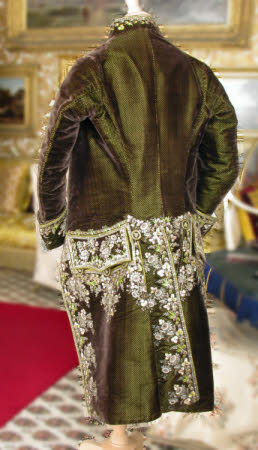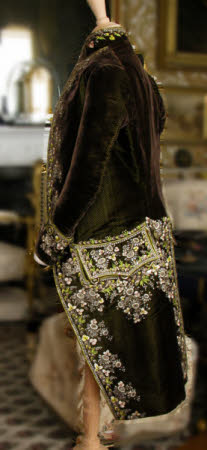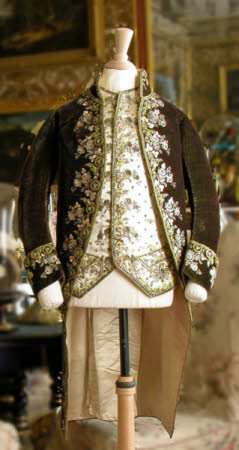Gentleman's coat
Category
Costume
Date
1770 - 1800
Materials
Silk velvet, silk, silk and metal thread, glass paste and linen
Measurements
355 mm (Width); 1070 mm (L)
Order this imageCollection
Calke Abbey, Derbyshire
NT 292106
Caption
When this court suit of brown and gold velvet was worn, its flamboyant decoration would have sparkled and shone, especially in candlelight. An eye-catching demonstration of wealth and social status, it belonged to Sir Henry Harpur, 6th Baronet (1739–89), or his son Sir Henry Crewe, 7th Baronet (1763–1819), of Calke Abbey. The sartorial style of elite British men throughout the 18th century was as colourful and luxurious as fashion for women, and both followed trends originating in France. The embroidery decorating this velvet coat and waistcoat was sewn by a highly skilled professional French embroiderer. Floral sprays sweep down the front opening of the coat and around to the back pleats, matched to the decoration of the cuffs and pockets and contrasting cream silk waistcoat (NT 292107). The intricate stitches of silk and silver thread incorporate silver spangles and newly fashionable foil-backed glass pastes in imitation of diamonds and coloured precious stones. Emma Slocombe
Summary
A gentleman's brown velvet, heavily embroidered coat. Note pinned to the collar; '18th century coat worn by Sir Henry Harpur Bt. Lent by Sir V. Harpur Crewe'. The brown velvet has a tiny gold fleck. White satin lining. Stand-up collar, long sleeves with turn-up cuffs. Two pockets with large flaps. Flared skirt with a central vent. Intricate embroidery mainly in pink, yellow and white with sequins and glass paste beads and silver thread. Nine velvet covered buttons down the front. No buttonholes, fastens with hooks and eyes. Matching waistcoat NT 292107 (CAL/T/845).
Marks and inscriptions
18th century coat worn by Sir Henry Harpur Bt. Lent by Sir V. Harpur Crewe. (inscribed note)
References
Antrobus and Slocombe 2025: Helen Antrobus and Emma Slocombe, 100 Things to Wear: Fashion from the collections of the National Trust, National Trust 2025, pp. 84-85.


